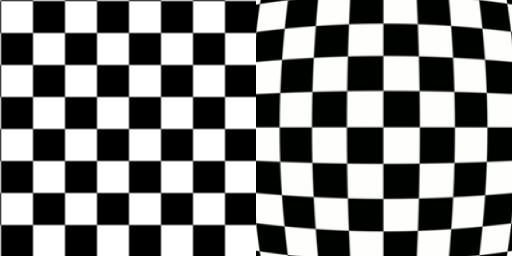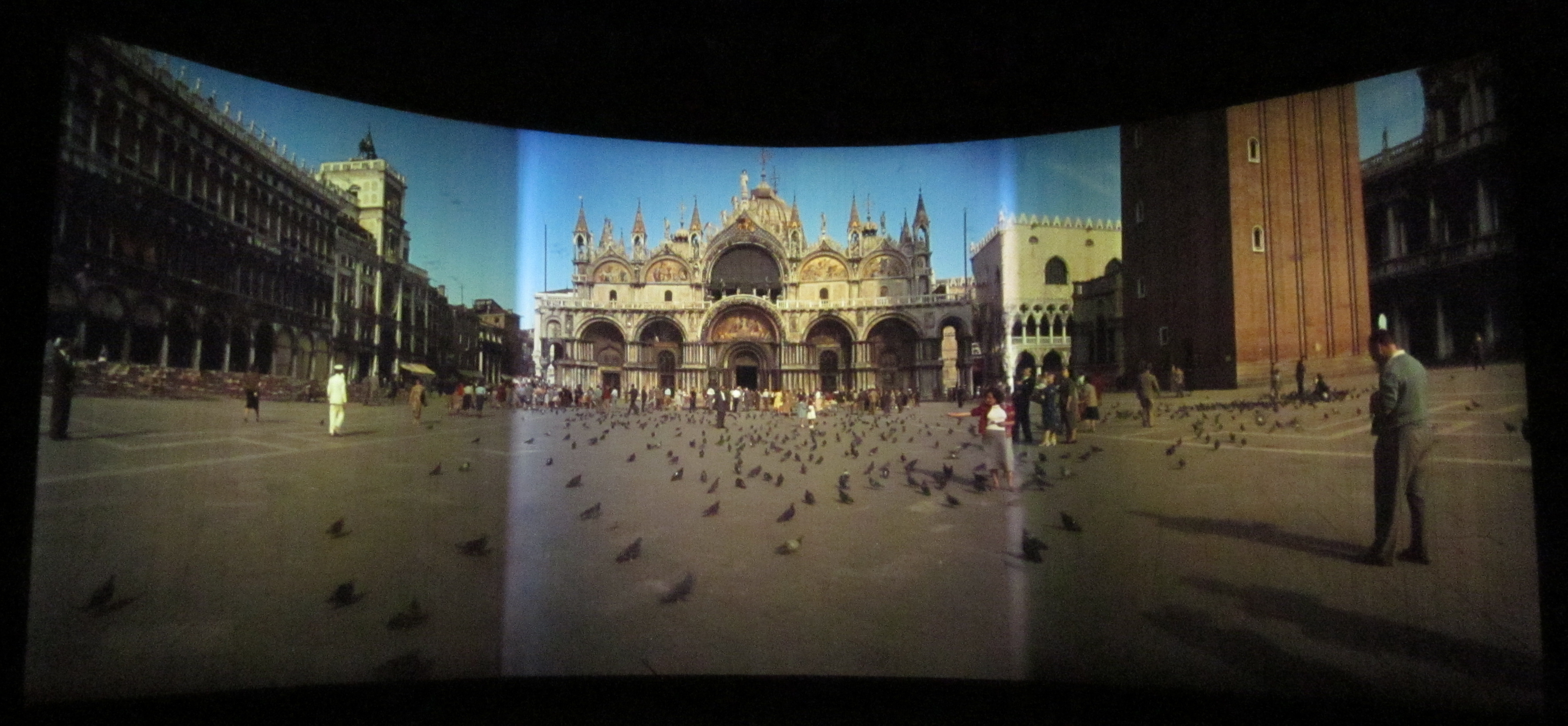|
Cylindrical Perspective
Cylindrical perspective is a form of distortion caused by fisheye and panoramic lenses which reproduce straight horizontal lines above and below the lens axis level as curved while reproducing straight horizontal lines on lens axis level as straight. This is also a common feature of wide-angle anamorphic lenses of less than 40mm focal length in cinematography, as well as the basis for creating the 146-degree peripheral vision of Cinerama Cinerama is a widescreen process that originally projected images simultaneously from three synchronized 35mm projectors onto a huge, deeply curved screen, subtending 146° of arc. The trademarked process was marketed by the Cinerama corporati ... when projected into a matching, cylindrically curved screen. See also * Distortion (optics) * Stretch-o-Vision Photographic techniques {{Photo-stub ... [...More Info...] [...Related Items...] OR: [Wikipedia] [Google] [Baidu] |
Distortion (optics)
In geometric optics, distortion is a deviation from rectilinear projection; a projection in which straight lines in a scene remain straight in an image. It is a form of aberration in optical systems, optical aberration. Radial distortion Although distortion can be irregular or follow many patterns, the most commonly encountered distortions are radially symmetric, or approximately so, arising from the symmetry of a photographic lens. These ''radial distortions'' can usually be classified as either ''barrel'' distortions or ''pincushion'' distortions. Mathematically, barrel and pincushion distortion are quadratic function, quadratic, meaning they increase as the ''square'' of distance from the center. In mustache distortion the quartic function, quartic (degree 4) term is significant: in the center, the degree 2 barrel distortion is dominant, while at the edge the degree 4 distortion in the pincushion direction dominates. Other distortions are in principle possible ... [...More Info...] [...Related Items...] OR: [Wikipedia] [Google] [Baidu] |
Fisheye Lens
A fisheye lens is an ultra wide-angle lens that produces strong visual distortion intended to create a wide panoramic or hemispherical image. Fisheye lenses achieve extremely wide angles of view, well beyond any rectilinear lens. Instead of producing images with straight lines of perspective ( rectilinear images), fisheye lenses use a special mapping ("distortion"; for example: equisolid angle, see below), which gives images a characteristic convex non-rectilinear appearance. The term ''fisheye'' was coined in 1906 by American physicist and inventor Robert W. Wood based on how a fish would see an ultrawide hemispherical view from beneath the water (a phenomenon known as Snell's window). Their first practical use was in the 1920s for use in meteorology to study cloud formation giving them the name "whole-sky lenses". The angle of view of a fisheye lens is usually between 100 and 180 degrees, although lenses covering up to 280 degrees exist (see below). Their focal lengths dep ... [...More Info...] [...Related Items...] OR: [Wikipedia] [Google] [Baidu] |
Panoramic Lens
Panoramic photography is a technique of photography, using specialized equipment or software, that captures images with horizontally elongated fields of view. It is sometimes known as ''wide format photography''. The term has also been applied to a photograph that is cropped to a relatively wide aspect ratio, like the familiar letterbox format in wide-screen video. While there is no formal division between " wide-angle" and " panoramic" photography, "wide-angle" normally refers to a type of lens, but using this lens type does not necessarily make an image a panorama. An image made with an ultra wide-angle fisheye lens covering the normal film frame of 1:1.33 is not automatically considered to be a panorama. An image showing a field of view approximating, or greater than, that of the human eye – about 160° by 75° – may be termed panoramic. This generally means it has an aspect ratio of 2:1 or larger, the image being at least twice as wide as it is high. The resulting image ... [...More Info...] [...Related Items...] OR: [Wikipedia] [Google] [Baidu] |
Lens Axis
An optical axis is a line along which there is some degree of rotational symmetry in an optical system such as a camera lens, microscope or telescopic sight. The optical axis is an imaginary line that defines the path along which light propagates through the system, up to first approximation. For a system composed of simple lenses and mirrors, the axis passes through the center of curvature of each surface, and coincides with the axis of rotational symmetry. The optical axis is often coincident with the system's mechanical axis, but not always, as in the case of off-axis optical systems. For an optical fiber, the optical axis is along the center of the fiber core, and is also known as the ''fiber axis''. See also * Ray (optics) * Cardinal point (optics) * Antenna boresight In telecommunications and radar engineering, antenna boresight is the axis of maximum gain (maximum radiated power) of a directional antenna. For most antennas the boresight is the axis of symmetry of the ... [...More Info...] [...Related Items...] OR: [Wikipedia] [Google] [Baidu] |
Anamorphic Lens
Anamorphic format is the cinematography technique of shooting a widescreen picture on standard 35 mm film or other visual recording media with a non-widescreen native aspect ratio. It also refers to the projection format in which a distorted image is "stretched" by an anamorphic projection lens to recreate the original aspect ratio on the viewing screen (not to be confused with anamorphic widescreen, a different video encoding concept that uses similar principles but different means). The word ''anamorphic'' and its derivatives stem from the Greek ''anamorphoun'' ("to transform"), compound of ''morphé'' ("form, shape") with the prefix ''aná'' ("back, against"). In the late 1990s and 2000s, anamorphic lost popularity in comparison to "flat" (or "spherical") formats such as Super 35 with the advent of digital intermediates; however, in the years since digital cinema cameras and projectors have become commonplace, anamorphic has experienced a considerable resurgence of popularit ... [...More Info...] [...Related Items...] OR: [Wikipedia] [Google] [Baidu] |
Cinematography
Cinematography (from ancient Greek κίνημα, ''kìnema'' "movement" and γράφειν, ''gràphein'' "to write") is the art of motion picture (and more recently, electronic video camera) photography. Cinematographers use a lens to focus reflected light from objects into a real image that is transferred to some image sensor or light-sensitive material inside a movie camera. These exposures are created sequentially and preserved for later processing and viewing as a motion picture. Capturing images with an electronic image sensor produces an electrical charge for each pixel in the image, which is electronically processed and stored in a video file for subsequent processing or display. Images captured with photographic emulsion result in a series of invisible latent images on the film stock, which are chemically " developed" into a visible image. The images on the film stock are projected for viewing the same motion picture. Cinematography finds uses in many fields of ... [...More Info...] [...Related Items...] OR: [Wikipedia] [Google] [Baidu] |
Cinerama
Cinerama is a widescreen process that originally projected images simultaneously from three synchronized 35mm projectors onto a huge, deeply curved screen, subtending 146° of arc. The trademarked process was marketed by the Cinerama corporation. It was the first of a number of novel processes introduced during the 1950s, when the movie industry was reacting to competition from television. Cinerama was presented to the public as a theatrical event, with reserved seating and printed programs, and audience members often dressed in their best attire for the evening. The Cinerama projection screen, rather than being a continuous surface like most screens, is made of hundreds of individual vertical strips of standard perforated screen material, each about inch (~22 mm) wide, with each strip angled to face the audience, so as to prevent light scattered from one end of the deeply curved screen from reflecting across the screen and washing out the image on the opposite end. ... [...More Info...] [...Related Items...] OR: [Wikipedia] [Google] [Baidu] |
Stretch-o-Vision
A video scaler is a system which converts video signals from one display resolution to another; typically, scalers are used to convert a signal from a lower resolution (such as 480p standard definition) to a higher resolution (such as 1080i high definition), a process known as "upconversion" or "upscaling" (by contrast, converting from high to low resolution is known as "downconversion" or "downscaling"). Video scalers are typically found inside consumer electronics devices such as televisions, video game consoles, and DVD or Blu-ray players, but can also be found in other AV equipment (such as video editing and television broadcasting equipment). Video scalers can also be a completely separate devices, often providing simple video switching capabilities. These units are commonly found as part of home theatre or projected presentation systems. They are often combined with other video processing devices or algorithms to create a video processor that improves the apparent defin ... [...More Info...] [...Related Items...] OR: [Wikipedia] [Google] [Baidu] |




_(14929131291).jpg)

